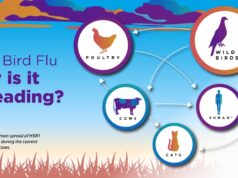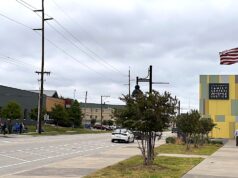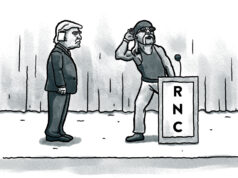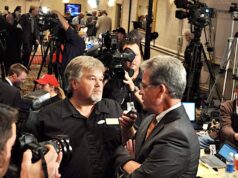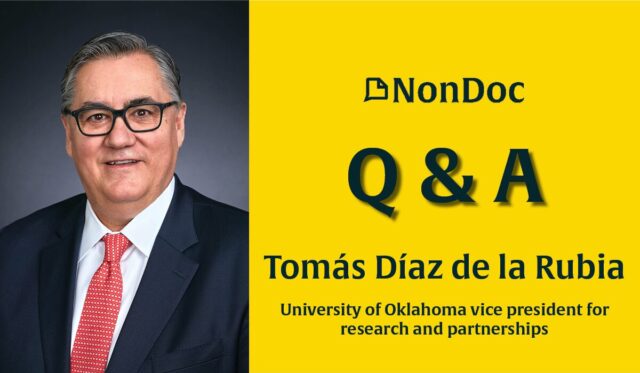

Growing up in Spain, science was a common subject of conversation in Tomás Díaz de la Rubia’s home. His father was and engineer and his grandfather was a chemist.
That childhood interest in how things work carried him to the United States and a long career in academia with stops at SUNY Albany, Purdue University and the University of Oklahoma.
Today, Tomás Díaz de la Rubia is OU’s vice president for research and partnerships, a position he assumed in 2019.
In this Q&A, Díaz de la Rubia talks about science, STEM and his love for Formula One racing. The following conversation has been edited lightly for clarity, style and brevity.
Where did you grow up, what were your formative educational and professional experiences, and what spurred your interest in science?
I grew up in the Asturias region of Spain, a small province in the northwest surrounded by the ocean and beautiful mountains. My interest in science started from a very young age. My father was an engineer, and my grandfather was a chemist, so science and engineering were always in the air at home. Early on I became fascinated by physics, especially nuclear physics and cosmology. In my early teens, I started reading the Spanish edition of Scientific American, which my parents got me a subscription to, and it all went from there.
In 1981, after having started college in Spain, I decided to come to the U.S. to study physics. Those early undergraduate days and the ability at SUNY Albany to do research from a very early time truly changed my life. I was allowed to do research on materials in a particle accelerator, and I became fascinated by the process of discovery and the scientific method. It was then that I knew I wanted a career in research.
After getting my Ph.D., I decided to join the University of California Lawrence Livermore National Laboratory. At that time, and still today, LLNL had some of the world’s largest supercomputers and lasers, and I knew that was the place for me. I had an amazing 24-year career there, where I was involved in many large-scale scientific discovery efforts, including the development of the world’s largest laser, the National Ignition Facility, where fusion — the energy source that powers the sun and the stars — has been recently demonstrated for the first time in a laboratory environment on Earth. I also had the opportunity to be involved in the creation of completely new computational materials science methods, such as dislocation dynamics and their implementation on the world’s largest supercomputers at the time. During those years, I also got experience in leading and managing large teams of scientists and engineers doing mission-driven applied science and technology, and that experience has shaped everything I do today.
In 2015, I had the opportunity to join Purdue University as a professor of materials science and executive director of Discovery Park. DP is a complex of centers and institutes at Purdue that is focused on truly multidisciplinary research. During those years at Purdue, we focused on several large strategic initiatives and launched a new global security and defense institute and several new institutes focused on drug discovery, the life sciences, public policy, and other topics. We also created the Nexus Institute, a major sustainability initiative in Latin America that brings together faculty in the social and environmental sciences and the humanities and that is still going strong, not just at Purdue but now here at OU as well.
You came to OU from Purdue in 2019. What have been your biggest adjustments and biggest accomplishments over the past four years?
Undoubtedly, the biggest accomplishment has been the development and implementation of the Lead On, University Strategic Plan. I am most proud of having been part of the team led by President Joe Harroz that helped craft the pillars of the plan, particularly Pillars 1 and 5, which have the largest intersection with the research mission of the university. Since the plan was first implemented, total research expenditures at OU have grown 50 percent, and we finished Fiscal Year 2023 with research revenue from federal and other sources at an all-time high. For me, one of the most important accomplishments of these years has been the establishment of a framework for research based on the idea of transdisciplinary convergence, which allows us to think about how academia can come together in teams across traditional academic boundaries to tackle global grand challenges and create solutions with true impact on society. The culture of research and creative activity excellence is growing at OU, and the university is now well poised for continued growth and impact. While our ambition is to continue growing, we can say that we truly are today one of the nation’s top-tier public research universities.
Looking to the future, we have tremendous opportunities in front of us. With help and support from our congressional delegation and Department of Defense partners at Tinker Air Force Base and elsewhere, our aerospace and defense work is growing at an extraordinary pace, and our new facilities, which the state of Oklahoma has generously supported these last few years, will enable us to develop ideas and technologies at a level of sophistication that few universities anywhere are able to. Our College of Atmospheric and Geographic Sciences continues to be the best in the nation, and the research that is taking place is today more important than ever. As the climate continues to change, the incidence and severity of extreme weather events continue to rise, as does the cost in lives and property of such events.
OU’s work in partnership with the National Oceanographic and Atmospheric Administration in extreme and severe weather prediction and response is leading the nation and the world in the creation of better predictive tools that will help communities prepare for and respond to such severe weather events in the future and, therefore, save lives. OU’s faculty are also having tremendous success expanding their energy research activities into new areas of sustainable, carbon-free technologies such as hydrogen, geothermal, battery technology, and others. Beyond that, OU has a tremendous opportunity to grow the scale and impact of its biomedical research by bringing together the scientific and engineering community of the Norman campus with the OU Health Sciences’ medical and clinical research community. Today, more than ever, the convergence of the physical sciences, the social sciences, the humanities, data science tools such as AI and machine learning, engineering, and the life and biomedical sciences promises to revolutionize the future of health and health care. Few universities are as well positioned as OU to grow in this area of discovery and translation.
During a Nov. 30 presentation you made to the OU Board of Regents, you referenced massive global issues facing humanity right now, including climate change, social unrest and disease. For those who missed your presentation, please describe these global challenges and the role of technology in seeking solutions.
We live in a time when global social megatrends present the planet with wicked problems that are broad, challenging and complex: a world population topping 10 billion; rising inequality; pandemics and health disparities; doubling, and even tripling, energy demand; changes in weather patterns and impacts of climate change; world-wide need for access to clean water; geopolitical shifts and international conflict; asymmetric threats and unconventional sources of insecurity and disinformation. We face many challenges to sustain and improve our planet’s quality of life, today and for decades to come.
Nonetheless, we also live in an era of tremendous promise and abundance. Today more than ever, the rapid and global pace of innovation and the democratization of technology are bringing opportunity and a higher quality of life to many around the world. While much work remains to eliminate inequities and further democratize access to technology, the future is promising, and research universities such as the University of Oklahoma have a strong role to play in making this future a reality.
OU is collaborating with NASA and Lockheed Martin to build a satellite called the Geostationary Carbon Cycle Observatory. What can you tell us about the origin, function and timeline of this project?
GeoCarb, as the satellite is called, will be a critical instrument in the arsenal to measure greenhouse gas emissions and fluxes between the Earth and the atmosphere. The data that will be collected by GeoCarb will help us better understand the relationship between human activities, natural phenomena, and the changing environment and climate. The instrument that will be flown up to space in a satellite was recently completed by a team of OU and Lockheed Martin scientists and engineers. We are now working on securing a ride to space and into so-called geostationary orbit more than 22,000 miles above the Earth.
You also mentioned on Nov. 30 that you believe OU has a significant opportunity to foster and support a new manufacturing industry in Oklahoma for the next generation of weather radar. What research is occurring on radars right now, and what could this opportunity look like?
The Advanced Radar Research Center at OU is the nation’s foremost academic research center in its field. The technologies being developed at the ARRC are the most advanced when it comes to detecting weather patterns with the highest accuracy and precision, and they have the potential to become the next-generation weather radar systems for the nation in the decades to come.
We believe that as the federal government starts to replace the existing aging network of weather radars around the nation in the next two decades, OU and the state of Oklahoma are in an excellent position to capitalize on the opportunity and develop and manufacture the next generation weather radar here in Oklahoma because of the work at the ARRC. Since the future market for advanced next-generation radar technology is so broad and large, we believe an opportunity like this could result in hundreds of new
high-tech manufacturing jobs here in our region.
In your opinion, what is the most important way we can foster an interest in and appreciation of science for young people?
As a nation, we are failing when it comes to preparing young people for careers in STEM, particularly in K-12 math education. This trend is particularly acute in rural and underserved communities across the country. We need to help kids gain visibility into and get excited by the wonders of science from a very early age, and for this we need to help teachers across the state and country acquire the skills necessary to transmit that wonder and excitement in a manner that is accessible to all.
At OU, our College of Education is a national leader in this area, and through our K20 center and the U.S. Department of Education-funded GEAR UP programs, we are working across the state of Oklahoma to help kids and teachers get excited about and be better prepared for careers in STEM fields. This initiative is a perfect example of what we as a nation need to do and do more of to help everyone thrive in a society and culture strongly influenced and dominated by STEM-related markets and jobs.
In a 2020 article published by The OU Daily, a friend referenced your interests in tennis and Formula One race car driving. If you had to go back in time, wave a magic wand and pick a career outside of academia, would you rather be a professional tennis player or a race car driver, and why?
Absolutely a professional Formula One race car driver. The skill and preparation required to drive at the top of the sport in Formula One are unbelievable. Only the very best in the world get there, and that challenge just seems amazing to me. Having said that, I also know I would have failed miserably in my quest to become a Formula One driver, so it’s probably best that I became a scientist!









